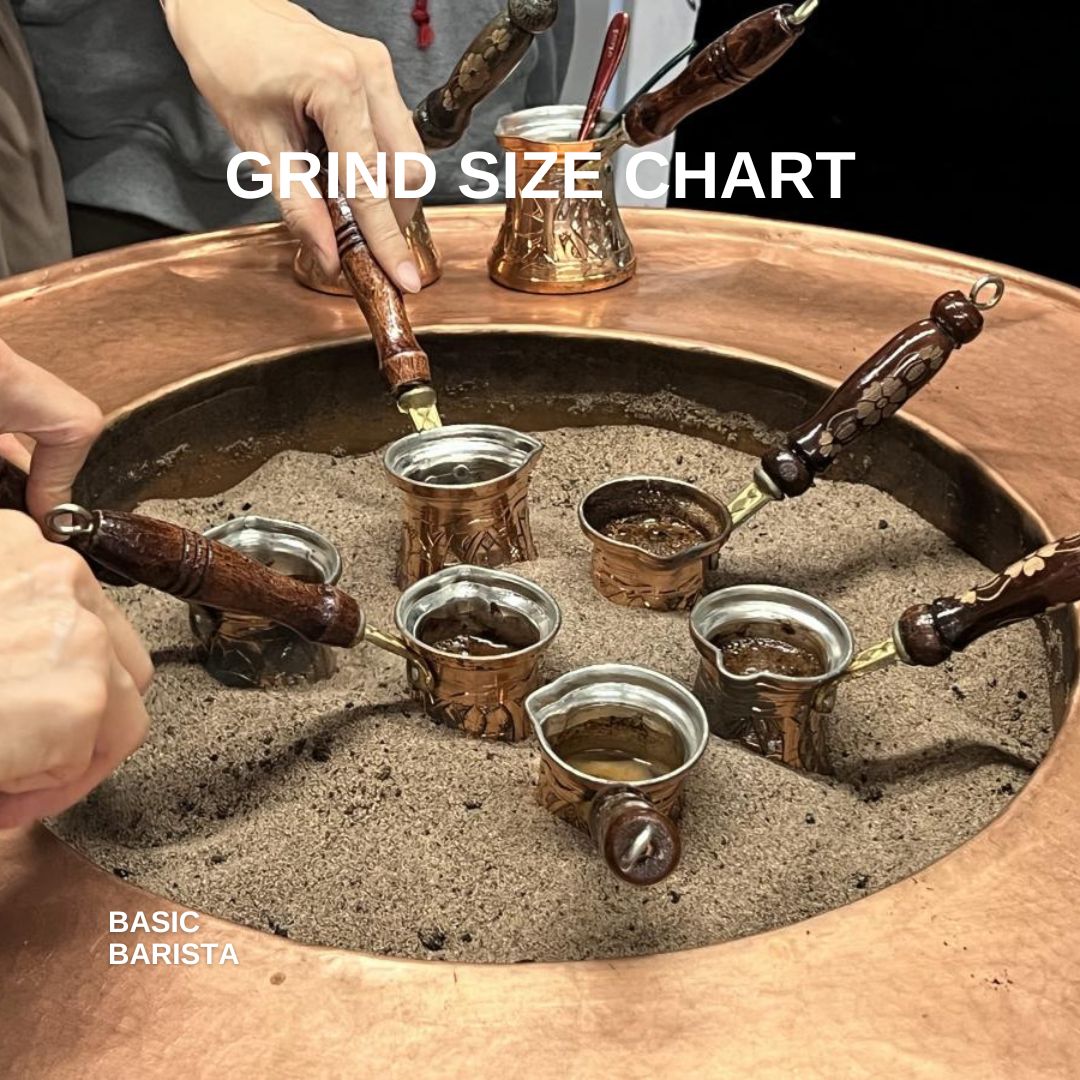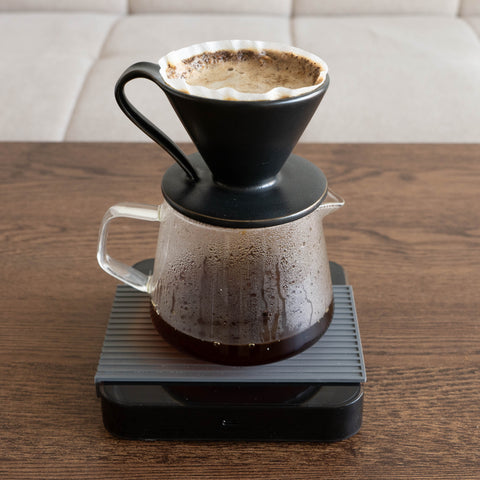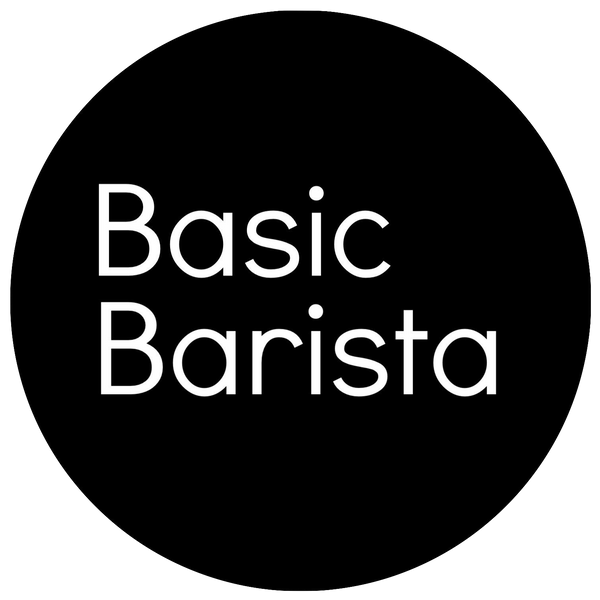
Brew Methods - Coffee Grind Size Chart
Share this article

Turkish coffee
40-220 microns
Turkish coffee is traditionally prepared by simmering finely ground coffee and water in a small pot. Unlike other popular brew methods, the coffee grounds remain in the final cup.
Turkish coffee is an immersion brewing method that doesn't require separating the coffee grounds from the water before drinking. This means issues typically caused by grinding coffee too finely, such as clogging an Aeropress or causing channeling in an espresso machine, are not concerns with Turkish coffee.
Therefore, Turkish coffee uses an even finer grind size compared to espresso, ranging from about 40 to 220 microns. This extremely fine grind, with a powder-like consistency, allows for complete extraction of the coffee particles during brewing, resulting in a rich and intense flavour profile.
Espresso
180-380 microns
The grind size for espresso will vary depending on the recipe you're folowing and the desired taste, each coffee bean will require a different grind size when brewing espresso and if this is intended to be drank with milk in the form of a latte or flat white, it is important to remember to taste the coffee with milk as this may not always transfer when tasting just the espresso.
The precise grind size required for espresso is due to the intense brewing conditions it involves, such as high pressure forcing water through the coffee grounds.
These extreme conditions mean that any small variation in grind size can significantly impact the extraction process, leading to either over-extraction or under-extraction more noticeably than in other brewing methods.
For espresso coffee brewing, the grind size should range between 180 and 380 microns. A finer grind provides a greater surface area of coffee for the water to interact with, which helps to extract the most desirable flavours quickly during the brief brewing period.

Batch Brew Coffee
300-900 microns
Filter coffee machine and drip coffee machine are general terms for any electrical coffee brewer that uses a percolation or pour over mechanism to make large batches of filter coffee.
The grind size varies hugely depending on the maker and model of the machine. In most cases the grind size falls between medium fine or around 300-900 microns.
AeroPress Coffee
320-960 microns
The AeroPress has the largest range on this list, the grind size measuring 320 and 960 microns. The AeroPress is a versatile coffee brewer, allowing for many different brewing methods, techniques and customisation.
The AeroPress, invented by Alan Adler, is designed to be a compact, portable, and convenient coffee maker. Since its debut in 2005, it has quickly become a favourite among coffee enthusiasts. Its versatility allows for various brewing methods, such as the inverted technique, which can accommodate coarser grinds. Over time, independent enthusiasts have developed a range of accessories, including metal filters, funnels, special cups, and attachable pour-over cones to enhance the AeroPress experience.
Your ideal grind size will depend on your routine, equipment, brewing method, and personal technique. We suggest starting with a medium grind size and adjusting from there to find the perfect setting for your taste.

Moka pot
360-660 microns
The Moka pot, also known as a stovetop espresso maker, is a classic coffee brewing device that has been cherished by coffee enthusiasts since its invention in 1933 by Italian engineer Alfonso Bialetti. This iconic brewer uses steam pressure to push hot water through finely-ground coffee, producing a strong, rich, and aromatic brew that is often compared to espresso.
Compact and easy to use, the Moka pot has become a staple in many households around the world, offering a simple way to enjoy a robust coffee experience without the need for an espresso machine. Its unique design, characterised by an octagonal shape and a three-chambered structure, has remained largely unchanged for decades, reflecting its timeless appeal and effectiveness in brewing delicious coffee.
It is also referred to brand names like Mélior, Bialetti and Bodum. The grind size for a Moka pot can fall between 360-660 microns.

Siphon Coffee
375-800 microns
A siphon, or vacuum coffee brewer, is an immersion-style coffee maker that utilises the principles of vapour pressure and vacuum to brew coffee. This method provides a unique and visually captivating way to prepare coffee, often resembling a scientific experiment.
The siphon consists of two chambers: the lower chamber, which holds water, and the upper chamber, where the coffee grounds are placed. The brewing process begins by heating the water in the lower chamber. As the water heats up, vapour pressure builds, forcing the hot water up through a tube and into the upper chamber, where it mixes with the coffee grounds.
The water remains in contact with the coffee grounds for a set amount of time, allowing for a full immersion brew that extracts a wide range of flavours. Once the brewing time is complete, the heat source is removed, and the brewed coffee is drawn back down into the lower chamber through a filter, thanks to the vacuum created as the device cools. This process not only produces a clean, aromatic coffee but also gives the brewer complete control over the variables that affect extraction, such as water temperature and brew time.
Choosing the right grind size is crucial for the siphon brewing process. A medium to medium-fine grind, typically between 375 and 800 microns, ensures an optimal flow of water through the coffee grounds, preventing any clogging of the filter or the passage of fine particles into the lower chamber. This grind size helps maintain a steady extraction rate, which is essential for achieving a balanced cup that showcases the coffee’s nuanced flavours without bitterness or over-extraction.
HARIO V60 - Pour Over Coffee
400-700 microns
The Hario V60 is a renowned pour-over coffee brewing device developed by the Japanese company Hario. It derives its name from its unique 'V' shaped design with a 60º angle, which is engineered to optimise the brewing process. The V60 is available in various materials, including ceramic, glass, plastic, and stainless steel, each offering different thermal properties and aesthetic appeal. The dripper's inner walls feature distinctive spiral ridges, which are designed to regulate the flow of water, promoting a controlled and steady pour.
This design element is crucial for achieving a more even extraction of coffee grounds, enhancing the flavour profile of the brew.
In fact, the V60 has been used to win six of the last eleven World Brewers Cup competitions, underscoring its reputation for precision and quality in the coffee brewing community.
To achieve optimal results with a V60, a finer grind size is recommended compared to most other pour over methods, typically ranging from 400 to 700 microns. This finer grind allows for a slower drawdown, ensuring the coffee grounds are adequately saturated and extracted, which contributes to a well balanced and flavourful cup. The V60’s ability to deliver a clean, bright, and nuanced cup of coffee makes it a favourite among both professional baristas and home brewers.

Pour Over Coffee
410-930 microns
Pour over coffee, also known as drip coffee, manual percolation, manual drip, or filter brew, is one of the oldest forms of brewing coffee by percolation. Its origins can be traced back to ancient Ethiopia and Yemen, where early methods of brewing involved carefully pouring hot water over ground coffee to extract flavours in a controlled fashion. This traditional approach laid the foundation for modern pour-over techniques.
Today, pour over coffee brewing involves pouring hot water over coffee grounds placed in a cone or funnel-shaped dripper fitted with a filter, usually made of paper or cloth. The water flows through the grounds and filter by gravity, allowing the coffee to extract slowly and evenly, which enhances the coffee’s flavour profile and highlights its unique characteristics.
Modern pour over drippers such as the V60, Orea, Origami Dripper and the Kalita Wave each bring their own distinct features and benefits to the brewing process. These differences can include variations in the design, such as the shape of the dripper, the type of filter used, and the flow rate of the water, all of which can subtly influence the taste and strength of the coffee. While the ideal grind size for pour-over coffee can vary slightly depending on the specific device, the grind typically falls within a medium range to ensure a balanced extraction.
For optimal results, we recommend adjusting your grinder to a setting between 410 and 930 microns. This range allows for a medium to medium - coarse grind size, which is suitable for most pour over brew methods. The chosen grind size should enable the water to flow steadily through the coffee grounds, promoting a balanced extraction that captures the coffee's full spectrum of flavours without over extraction or under-extraction.
Pour over brewing is a precise and mindful process, offering coffee enthusiasts the opportunity to explore the delicate nuances and subtleties of their favourite beans.

Cupping Coffee
460-850 microns
Cupping coffee is a structured method used to taste and evaluate coffee beans by examining their aroma, flavour, body, acidity, and other characteristics. This process is essential for farmers, roasters, green coffee buyers, and other coffee professionals to assess the quality and consistency of different coffee beans.
During cupping, a variety of coffee beans are ground and placed in small cups, allowing tasters to sample and evaluate the brew by spooning it out. The grind size for cupping is typically medium-fine and above, according to guidelines from various organisations and professionals.
Based on these standards, we recommend a grind size range of 470 to 850 microns for cupping to achieve an optimal extraction and flavour profile.

French Press Coffee
690-1300 microns
Brewing coffee with a French press involves steeping coarsely ground coffee in hot water and then using a plunger with a metal mesh filter to separate the brewed coffee from the grounds. This method typically requires a coarse grind size because the mesh filter of the French press is not fine enough to trap smaller coffee particles effectively.
As a result even with a coarse grind, some fine particles will likely remain in the final brew, contributing to the French press's distinctive rich and full bodied texture with a slightly cloudy appearance.
The unique design of the French press allows coffee oils and fine sediments to pass through the filter, unlike other brewing methods that use paper filters to remove these elements. This results in a fuller flavour and a heavier mouthfeel, which many coffee enthusiasts appreciate for its robust, earthy qualities. The presence of these oils and fine coffee particles gives French press coffee its signature taste profile a deep, complex flavour with a more pronounced richness and texture.
Due to the nature of the French press and its brewing process, we have determined that the ideal grind size should range from 690 to 1300 microns. This range allows for optimal extraction, balancing the infusion of flavours with the need to prevent over extraction and excessive sediment. By using the correct grind size, you can ensure that your French press coffee retains its beloved characteristics while achieving a well rounded and satisfying cup.

Cold Brew Coffee
800 microns +
Cold brew is a coffee brewing technique that involves steeping coarse coffee grounds in cold or room temperature water for an extended period, typically between 12 to 24 hours.
Unlike traditional hot brewing methods, cold brew relies on time rather than heat to extract flavors from the coffee. This slow, gentle extraction process results in a coffee that is generally smoother and less acidic, with a naturally sweeter taste profile.
Due to the lengthy steeping time and the cooler water temperature, a very coarse grind size is ideal for cold brew. This allows for a balanced extraction that prevents over-extraction, which can lead to a bitter taste. We recommend using a grind size between 800 to 1400 microns for cold brew, but some methods may require an even coarser grind to achieve the perfect flavor. The coarser grind helps in ensuring that the extraction is even and the resulting brew is clean, bold, and refreshing.
Cold Drip Coffee
820-1270 microns
Cold drip is a coffee brewing method that involves slowly dripping cold or room temperature water through coffee grounds over an extended period, usually lasting between 4 to 24 hours.
This process is carefully controlled to ensure a slow extraction, resulting in a smooth, concentrated coffee with low acidity and a rich, nuanced flavour profile. The final product is a concentrated coffee that can be diluted with water or milk or enjoyed over ice for a refreshing drink.
For cold drip brewing, using coarse coffee grounds is essential to prevent over-extraction and ensure a balanced flavour. The coarser grind helps regulate the water flow and avoids clogging the drip mechanism, which could result in an overly strong or bitter brew.
However, unlike cold brew, where a coarser grind can be beneficial to extending steep time, going too coarse with cold drip can accelerate the brewing process, reducing the intended duration of the drip.
For this reason, a grind size between 820 and 1270 microns is recommended to maintain the slow, steady extraction that characterises cold drip coffee. This grind size allows for a controlled drip rate and ensures that the coffee's flavours are fully developed without becoming overly extracted.







